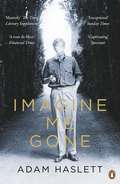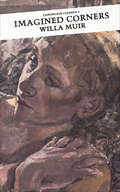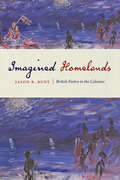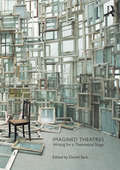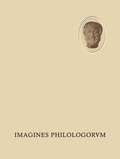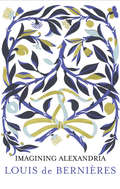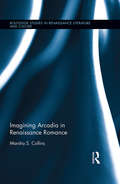- Table View
- List View
Imagine Me Gone
by Adam HaslettShortlisted for the NATIONAL BOOK CRITICS CIRCLE AWARDS 20172017 PULITZER PRIZE Finalist for Fiction TIME Top Ten Novels of 2016 'It might be the best American novel about a middle-class family since Jonathan Franzen's The Corrections' Independent'Exceptional, haunting, distinctive... [It] resembles the work of Anne Tyler, intertwining grief and love... Intimate and panoramic' The Sunday Times'Dreadfully sad and hilariously funny. Literature of the highest order' Peter CareyUniversal and essential, the heart-breaking story of an ordinary American family shaped by tragedyMichael's father walked into the woods one day, and out of his family's life for ever. Yet he and his brother and sister see it less as a tragedy in their past and more as a forewarning of the future. For Michael - smart, brilliant, so alive and vital - feels the darkness that drew their father away and how, given the chance, it might take the whole family. He wants to save them - but can he save himself?
Imagine Wanting Only This (Pantheon Graphic Library)
by Kristen RadtkeImagine Wanting Only This is a haunting graphic memoir about leaving, and those left behind.After the sudden death of a beloved uncle, Kristen becomes obsessed with abandoned places – derelict Midwestern mining towns, an Icelandic village preserved in volcanic ash, Cambodian temples reclaimed by jungle. At the same time, she examines what it means to be an artist, to be hungry for the next experience, to be always in transit. Beautifully illustrated in black and white, Imagine Wanting Only This confirms Kristen Radtke as an important new voice in the comics world.
The Imagined Arctic in Speculative Fiction (Routledge Studies in World Literatures and the Environment)
by Maria Lindgren LeavenworthThe Imagined Arctic in Speculative Fiction explores the ways in which the Arctic is imagined and what function it is made to serve in a selection of speculative fictions: non-mimetic works that start from the implied question "What if?" Spanning slightly more than two centuries of speculative fiction, from the starting point in Mary Shelley’s 1818 Frankenstein to contemporary works that engage with the vast ramifications of anthropogenic climate change, analyses demonstrate how Arctic discourses are supported or subverted and how new Arctics are added to the textual tradition. To illuminate wider lines of inquiry informing the way the world is envisioned, humanity’s place and function in it, and more-than-human entanglements, analyses focus on the function of the actual Arctic and how this function impacts and is impacted by speculative elements. With effects of climate change training the global eye on the Arctic, and as debates around future northern cultural, economic and environmental sustainability intensify, there is a need for a deepened understanding of the discourses that have constructed and are constructing the Arctic. A careful mapping and serious consideration of both past and contemporary speculative visions thus illuminate the role the Arctic has played and may come to play in a diverse set of practices and fields.
The Imagined Arctic in Speculative Fiction (Routledge Studies in World Literatures and the Environment)
by Maria Lindgren LeavenworthThe Imagined Arctic in Speculative Fiction explores the ways in which the Arctic is imagined and what function it is made to serve in a selection of speculative fictions: non-mimetic works that start from the implied question "What if?" Spanning slightly more than two centuries of speculative fiction, from the starting point in Mary Shelley’s 1818 Frankenstein to contemporary works that engage with the vast ramifications of anthropogenic climate change, analyses demonstrate how Arctic discourses are supported or subverted and how new Arctics are added to the textual tradition. To illuminate wider lines of inquiry informing the way the world is envisioned, humanity’s place and function in it, and more-than-human entanglements, analyses focus on the function of the actual Arctic and how this function impacts and is impacted by speculative elements. With effects of climate change training the global eye on the Arctic, and as debates around future northern cultural, economic and environmental sustainability intensify, there is a need for a deepened understanding of the discourses that have constructed and are constructing the Arctic. A careful mapping and serious consideration of both past and contemporary speculative visions thus illuminate the role the Arctic has played and may come to play in a diverse set of practices and fields.
Imagined Commonwealth: Cambridge Essays on Commonwealth and International Literature in English (Cambridge Commonwealth Series)
by T. J. CribbThis collection includes contributions from some of the major authors in the field. The critical essays have been chosen to open up possibilities, mark out boundaries and set objectives in the ever-expanding field of international literature in English. The writers themselves are the principal guides and resources for this enterprise. New literary and critical practices are derived from the problematic role of English as an international language and from its relations with other languages. Values of cultural difference and particularity are emphasised.
Imagined Corners (Canongate Classics #1)
by Willa MuirIntroduced by J.B. Pick. Willa Muir was an acute and acerbic observer with an intimate knowledge of the Scottish middle-class conventions she describes. In Imagined Corners, her first novel, young Elizabeth Shand, newly married to the unstable but handsome Hector, finds herself in the social, intellectual and spiritual strait-jacket of small-town life early this century. Into the growing complexity of these entangled relationships her sister-in-law and namesake returns from Italy, sophisticated and freshly widowed. Through her, Elizabeth rediscovers an intuitive desire to face life honestly and intelligently, and reassesses an enforced life of petty vanities and delusion against new possibilities of personal and sexual freedom.
Imagined Futures: Writing, Science, and Modernity in the To-Day and To-Morrow Book Series, 1923-31
by Max SaundersThis study provides the first substantial history and analysis of the To-Day and To-Morrow series of 110 books, published by Kegan Paul Trench and Trübner (and E. P. Dutton in the USA) from 1923 to 1931, in which writers chose a topic, described its present, and predicted its future. Contributors included J. B. S. Haldane, Bertrand Russell, Vernon Lee, Robert Graves, Vera Brittain, Sylvia Pankhurst, Hugh McDiarmid, James Jeans, J. D. Bernal, Winifred Holtby, André Maurois, and many others. The study combines a comprehensive account of its interest, history, and range with a discussion of its key concerns, tropes, and influence. The argument focuses on science and technology, not only as the subject of many of the volumes, but also as method—especially through the paradigm of the human sciences—applied to other disciplines; and as a source of metaphors for representing other domains. It also includes chapters on war, technology, cultural studies, and literature and the arts. This book aims to reinstate the series as a vital contribution to the writing of modernity, and to reappraise modernism's relation to the future, establishing a body of progressive writing which moves beyond the discourses of post-Darwinian degeneration and post-war disenchantment, projecting human futures rather than mythic or classical pasts. It also shows how, as a co-ordinated body of futurological writing, the series is also revealing about the nature and practices of modern futurology itself.
Imagined Futures: Writing, Science, and Modernity in the To-Day and To-Morrow Book Series, 1923-31
by Max SaundersThis study provides the first substantial history and analysis of the To-Day and To-Morrow series of 110 books, published by Kegan Paul Trench and Trübner (and E. P. Dutton in the USA) from 1923 to 1931, in which writers chose a topic, described its present, and predicted its future. Contributors included J. B. S. Haldane, Bertrand Russell, Vernon Lee, Robert Graves, Vera Brittain, Sylvia Pankhurst, Hugh McDiarmid, James Jeans, J. D. Bernal, Winifred Holtby, André Maurois, and many others. The study combines a comprehensive account of its interest, history, and range with a discussion of its key concerns, tropes, and influence. The argument focuses on science and technology, not only as the subject of many of the volumes, but also as method—especially through the paradigm of the human sciences—applied to other disciplines; and as a source of metaphors for representing other domains. It also includes chapters on war, technology, cultural studies, and literature and the arts. This book aims to reinstate the series as a vital contribution to the writing of modernity, and to reappraise modernism's relation to the future, establishing a body of progressive writing which moves beyond the discourses of post-Darwinian degeneration and post-war disenchantment, projecting human futures rather than mythic or classical pasts. It also shows how, as a co-ordinated body of futurological writing, the series is also revealing about the nature and practices of modern futurology itself.
Imagined Homelands: British Poetry in the Colonies
by Jason R. RudyImagined Homelands chronicles the emerging cultures of nineteenth-century British settler colonialism, focusing on poetry as a genre especially equipped to reflect colonial experience. Jason Rudy argues that the poetry of Victorian-era Australia, New Zealand, South Africa, and Canada;¢;‚¬;€?often disparaged as derivative and uncouth;¢;‚¬;€?should instead be seen as vitally engaged in the social and political work of settlement. The book illuminates cultural pressures that accompanied the unprecedented growth of British emigration across the nineteenth century. It also explores the role of poetry as a mediator between familiar British ideals and new colonial paradigms within emerging literary markets from Sydney and Melbourne to Cape Town and Halifax. Rudy focuses on the work of poets both canonical;¢;‚¬;€?including Tennyson, Browning, Longfellow, and Hemans;¢;‚¬;€?and relatively obscure, from Adam Lindsay Gordon, Susanna Moodie, and Thomas Pringle to Henry Kendall and Alexander McLachlan. He examines in particular the nostalgic relations between home and abroad, core and periphery, whereby British emigrants used both original compositions and canonical British works to imagine connections between their colonial experiences and the lives they left behind in Europe.Drawing on archival work from four continents, Imagined Homelands insists on a wider geographic frame for nineteenth-century British literature. From lyrics printed in newspapers aboard emigrant ships heading to Australia and South Africa, to ballads circulating in New Zealand and Canadian colonial journals, poetry was a vibrant component of emigrant life. In tracing the histories of these poems and the poets who wrote them, this book provides an alternate account of nineteenth-century British poetry and, more broadly, of settler colonial culture.
Imagined Homelands: British Poetry in the Colonies
by Jason R. RudyImagined Homelands chronicles the emerging cultures of nineteenth-century British settler colonialism, focusing on poetry as a genre especially equipped to reflect colonial experience. Jason Rudy argues that the poetry of Victorian-era Australia, New Zealand, South Africa, and Canada;¢;‚¬;€?often disparaged as derivative and uncouth;¢;‚¬;€?should instead be seen as vitally engaged in the social and political work of settlement. The book illuminates cultural pressures that accompanied the unprecedented growth of British emigration across the nineteenth century. It also explores the role of poetry as a mediator between familiar British ideals and new colonial paradigms within emerging literary markets from Sydney and Melbourne to Cape Town and Halifax. Rudy focuses on the work of poets both canonical;¢;‚¬;€?including Tennyson, Browning, Longfellow, and Hemans;¢;‚¬;€?and relatively obscure, from Adam Lindsay Gordon, Susanna Moodie, and Thomas Pringle to Henry Kendall and Alexander McLachlan. He examines in particular the nostalgic relations between home and abroad, core and periphery, whereby British emigrants used both original compositions and canonical British works to imagine connections between their colonial experiences and the lives they left behind in Europe.Drawing on archival work from four continents, Imagined Homelands insists on a wider geographic frame for nineteenth-century British literature. From lyrics printed in newspapers aboard emigrant ships heading to Australia and South Africa, to ballads circulating in New Zealand and Canadian colonial journals, poetry was a vibrant component of emigrant life. In tracing the histories of these poems and the poets who wrote them, this book provides an alternate account of nineteenth-century British poetry and, more broadly, of settler colonial culture.
Imagined Selves: Imagined Corners, Mrs Ritchie, Selected Non-fiction (Canongate Classics #69)
by Willa MuirThis volume gathers together some of the real and the imagined lives of Willa Muir, one of the finest and fiercest intellectuals of her generation. Her writing is rich with paradox - although obsessively Scottish in subject and style, she resented Scotland; although a trenchant champion of feminism, she voluntarily sacrificed her identity to that of the 'poet's wife'; and although she was a committed reformer, she never aligned herself with any political or ideological movement. These passionate dichotomies are intertwined in her writing, giving a particular power to her fiction and non-fiction alike. This collection is the first publication to offer a sense of the diversity of Willa Muir's oeuvre. It makes possible the re-evaluation of her work and assures her of a deserved place in the Scottish literary canon.
Imagined Spaces
by Gail Low and Kirsty GunnOur everyday senses supply only a small fraction of what we actually perceive—the rest is filled in by what we think we already know, or have learnt from newspapers and magazines, and other media. So how much of our experience is really thought about, felt and reflected upon? This ground-breaking anthology asks us to consider the space between the known and the unknown, between fact and the imagination, between the external and the internal. In words and images that explore our environment and culture, that reflect on literary and artistic creation, mortality, mental wellness, home and belonging, Imagined Spaces returns the essay to its original activity of having a go, trying and weighing something out, taking a risk. An exciting and provocative collection that is fun, entertaining, and deeply serious. Join us in the space that follows and be part of an adventure essaying into the unknown...
Imagined Theatres: Writing for a Theoretical Stage
by Daniel SackImagined Theatres collects theoretical dramas written by some of the leading scholars and artists of the contemporary stage. These dialogues, prose poems, and microfictions describe imaginary performance events that explore what might be possible and impossible in the theatre. Each scenario is mirrored by a brief accompanying reflection, asking what they might mean for our thinking about the theatre. These many possible worlds circle around questions that include: In what way is writing itself a performance? How do we understand the relationship between real performances that engender imaginary reflections and imaginary conceptions that form the basis for real theatrical productions? Are we not always imagining theatres when we read or even when we sit in the theatre, watching whatever event we imagine we are seeing?
Imagined Theatres: Writing for a Theoretical Stage
by Daniel SackImagined Theatres collects theoretical dramas written by some of the leading scholars and artists of the contemporary stage. These dialogues, prose poems, and microfictions describe imaginary performance events that explore what might be possible and impossible in the theatre. Each scenario is mirrored by a brief accompanying reflection, asking what they might mean for our thinking about the theatre. These many possible worlds circle around questions that include: In what way is writing itself a performance? How do we understand the relationship between real performances that engender imaginary reflections and imaginary conceptions that form the basis for real theatrical productions? Are we not always imagining theatres when we read or even when we sit in the theatre, watching whatever event we imagine we are seeing?
Imagines Philologorvm: 160 Bildnisse aus der Zeit von der Renaissance bis zur Gegenwart
by Alfred GudemanDieser Buchtitel ist Teil des Digitalisierungsprojekts Springer Book Archives mit Publikationen, die seit den Anfängen des Verlags von 1842 erschienen sind. Der Verlag stellt mit diesem Archiv Quellen für die historische wie auch die disziplingeschichtliche Forschung zur Verfügung, die jeweils im historischen Kontext betrachtet werden müssen. Dieser Titel erschien in der Zeit vor 1945 und wird daher in seiner zeittypischen politisch-ideologischen Ausrichtung vom Verlag nicht beworben.
Imagining a Postcolonial Nation: Hindi Novels and Forms of India (1940s-80s)
by YaminiThis book explores narratives of nationalism in the Hindi novel (1940s–80s), engaging with mainstream, populist, political conceptualisation of a postcolonial nation and local, cultural, often marginalised fictional parallels and alternatives to it.Analysing processes of nation-formation and nationalism(s) via experiments with the novel form and versions of realism in Hindi, conversations between the political and the cultural, rural/borders and the urban/central spaces, individual subjectivity and social structures, and the challenges Hindi novels' internal linguistic diversity poses to formalised Hindi's hegemony, Imagining a Postcolonial Nation: Hindi Novels and Forms of India (1940s–80s) traces Hindi fiction's history of postcolonial India. The multiplicity of realisms indicates significant responses to postcolonial nationalism, idealistic, critical, regional, satirical and psychological.Looking at indigenous narrative methods employed by authors to critically evolve Western ideas of the nation and novel, the book explores the simultaneous convergences and divergences between literary and political understandings of ideological, religious and linguistic nationalisms. Surveying the broad sentiments of idealism, enchantment and disenchantment with freedom and postcoloniality, it studies the possibilities of fiction embodying national history without an outright commitment to mainstream nationalism or nationalist literary canon formation.It also briefly tries to understand the repercussions of nationalism as a masculinist project and its gendered nature affecting a section of writing, novels by women authors, to present counter-narratives to both national and literary canons. Choosing a fairly broad historical timeframe, the book reveals the radical potential of narratives that have over the years been critically categorised as canonical. It reopens discussions around nationalism within novels that have been often canonised as apparently uncritically nationalist.
Imagining a Postcolonial Nation: Hindi Novels and Forms of India (1940s-80s)
by YaminiThis book explores narratives of nationalism in the Hindi novel (1940s–80s), engaging with mainstream, populist, political conceptualisation of a postcolonial nation and local, cultural, often marginalised fictional parallels and alternatives to it.Analysing processes of nation-formation and nationalism(s) via experiments with the novel form and versions of realism in Hindi, conversations between the political and the cultural, rural/borders and the urban/central spaces, individual subjectivity and social structures, and the challenges Hindi novels' internal linguistic diversity poses to formalised Hindi's hegemony, Imagining a Postcolonial Nation: Hindi Novels and Forms of India (1940s–80s) traces Hindi fiction's history of postcolonial India. The multiplicity of realisms indicates significant responses to postcolonial nationalism, idealistic, critical, regional, satirical and psychological.Looking at indigenous narrative methods employed by authors to critically evolve Western ideas of the nation and novel, the book explores the simultaneous convergences and divergences between literary and political understandings of ideological, religious and linguistic nationalisms. Surveying the broad sentiments of idealism, enchantment and disenchantment with freedom and postcoloniality, it studies the possibilities of fiction embodying national history without an outright commitment to mainstream nationalism or nationalist literary canon formation.It also briefly tries to understand the repercussions of nationalism as a masculinist project and its gendered nature affecting a section of writing, novels by women authors, to present counter-narratives to both national and literary canons. Choosing a fairly broad historical timeframe, the book reveals the radical potential of narratives that have over the years been critically categorised as canonical. It reopens discussions around nationalism within novels that have been often canonised as apparently uncritically nationalist.
Imagining Adoption: Essays on Literature and Culture
by Marianne NovyImagining Adoption looks at representations of adoption in an array of literary genres by diverse authors including George Eliot, Edward Albee, and Barbara Kingsolver as well as ordinary adoptive mothers and adoptee activists, exploring what these writings share and what they debate. Marianne Novy is Professor of English and Women's Studies, University of Pittsburgh.
Imagining Africa: Landscape in H. Rider Haggard's African Romances (Contributions to the Study of World Literature)
by Lindy StiebelBest known as the author of such works as King Solomon's Mines and She, H. Rider Haggard was one of the most popular writers of the late-Victorian era, and his works continue to be influential today. To a large degree, his novels are captivating because of his image of Africa, and an understanding of his representation of the African landscape is central to a critical reading of his works. This book argues that Haggard created in his African romances a formulaic, ideological geography which provided a canvas onto which he projected his desires and fears, both personal and political, as well as those of his age.The first full-length study of land and landscape in Haggard's African romances, this book approaches his construction of an imaginary African landscape as a product of late-Victorian wishful thinking about Africa, analyzing his African topography as a vast Eden, a wilderness, a dream underworld, a home to ancient white civilizations, and a sexualized metaphor for the human body. While the work looks primarily at his pre-1892 romances, which were his most powerful, it also gives attention to his nonfiction and unpublished papers. Because Haggard's writings embodied the spirit of his age, this book is an essential guide to late-Victorian concepts of Africa, colonization, and the British Empire.
Imagining Alexandria: Poems in Memory of C.P. Cavafy
by Louis De BernieresPoetry was Louis de Bernières’ first literary love and Imagining Alexandria is his debut poetry collection. Here the author of the much-loved Captain Corelli’s Mandolin returns us to the vivid Mediterranean landscape of his fiction.De Bernières was introduced to Greek poetry while in Corfu in 1983, and since then he has always travelled with a book of Cavafy's poetry in his pocket. Not surprisingly, his own poems about the distant past, the erotic and the philosophical owe much to the influence of the great Alexandrian poet.Beautifully illustrated with line drawings by Donald Sammut, this is a collection rich in sensuality, nostalgia, and music.
Imagining Andrew Marvell at 400 (Proceedings of the British Academy #249)
by Matthew C. Augustine, Giulio J. Pertile, Steven N. ZwickerAugustine, Pertile and Zwicker celebrate the work of Andrew Marvell (1621-1678) in the quatercentenary year of his birth, combining the best historical scholarship with a varied and ambitious programme of cognitive, affective, and aesthetic inquiry. The essays have been specially commissioned for the quatercentenary and include the work of a range of scholars from Britain and North America. Acknowledged masterpieces such as the 'Horatian Ode', 'The Garden', and 'Upon Appleton House' are here read in light of historical and material evidence that has emerged in recent decades. At the same time, the volume offers many fresh points of entry into Marvell's work, with particular attention to the poet's lyric economies, Marvell's engagement with popular print, and, not least, the polyglot and transnational dimensions of his writing. The quatercentenary also represents an important anniversary for Marvell studies, marking one hundred years since T. S. Eliot's appreciation of the poet inaugurated modern Marvell criticism. As Imagining Andrew Marvell at 400 reassesses Marvell's writings it also reflects on the profession of English literature, taking stock of the discipline itself, where it has been and where it might be going as scholars continue to map the pleasures and challenges of reading and re-reading Andrew Marvell.
Imagining Apocalyptic Politics in the Anthropocene (Routledge Environmental Humanities)
by Earl T. HarperBringing together scholars from English literature, geography, politics, the arts, environmental humanities and sociology, Imagining Apocalyptic Politics in the Anthropocene contributes to the emerging debate between bodies of thought first incepted by scholars such as Mouffe, Whyte, Kaplan, Hunt, Swyngedouw and Malm about how apocalyptic events, narratives and imaginaries interact with societal and individual agency historically and in the current political moment. Exploring their own empirical and philosophical contexts, the authors examine the forms of political acting found in apocalyptic imaginaries and reflect on what this means for contemporary society. By framing their arguments around either pre-apocalyptic, peri-apocalyptic or post-apocalyptic narratives and events, a timeline emerges throughout the volume which shows the different opportunities for political agency the anthropocenic subject can enact at the various stages of apocalyptic moments. Featuring a number of creative interventions exclusively produced for the work from artists and fiction writers who engage with the themes of apocalypse, decline, catastrophe and disaster, this innovative book will be of great interest to students and scholars of the politics of climate change, the environmental humanities, literary criticism and eco-criticism.
Imagining Apocalyptic Politics in the Anthropocene (Routledge Environmental Humanities)
by Earl T. Harper Doug SpechtBringing together scholars from English literature, geography, politics, the arts, environmental humanities and sociology, Imagining Apocalyptic Politics in the Anthropocene contributes to the emerging debate between bodies of thought first incepted by scholars such as Mouffe, Whyte, Kaplan, Hunt, Swyngedouw and Malm about how apocalyptic events, narratives and imaginaries interact with societal and individual agency historically and in the current political moment. Exploring their own empirical and philosophical contexts, the authors examine the forms of political acting found in apocalyptic imaginaries and reflect on what this means for contemporary society. By framing their arguments around either pre-apocalyptic, peri-apocalyptic or post-apocalyptic narratives and events, a timeline emerges throughout the volume which shows the different opportunities for political agency the anthropocenic subject can enact at the various stages of apocalyptic moments. Featuring a number of creative interventions exclusively produced for the work from artists and fiction writers who engage with the themes of apocalypse, decline, catastrophe and disaster, this innovative book will be of great interest to students and scholars of the politics of climate change, the environmental humanities, literary criticism and eco-criticism.
Imagining Arcadia in Renaissance Romance (Routledge Studies in Renaissance Literature and Culture)
by Marsha S. CollinsFrom Theocritus’ Idylls to James Cameron’s Avatar, Arcadia remains an enduring presence in world culture and a persistent source of creative inspiration. Why does Arcadia still exercise such a powerful pull on the imagination? This book responds by arguing that in sixteenth-century Europe, a dramatic shift took place in imagining Arcadia. The traditional visions of Arcadia collided and fused with romance, the new experimental form of prose fiction, producing a hybrid, dynamic world of change and transformation. Emphasizing matters of fictional function and world-making over generic classification, Imagining Arcadia in Renaissance Romance analyzes the role of romance as a catalyst in remaking Arcadia in five, canonical sixteenth-century texts: Sannazaro’s Arcadia; Montemayor’s La Diana; Cervantes’ La Galatea; Sidney’s Arcadia; and Lope de Vega’s Arcadia. Collins’ analyses of the re-imagined Arcadia in these works elucidate the interplay between timely incursions into the fictional world and the timelessness of art, highlighting issues of freedom, identity formation, subjectivity and self-fashioning, the intersection of public and private activity, and the fascination with mortality. This book addresses the under-representation of Spanish literature in Early Modern literary histories, especially regarding the rich Spanish contribution to the pastoral and to idealizing fiction in the West. Companion chapters on Cervantes and Sidney add to the growing field of Anglo-Spanish comparative literary studies, while the book’s comparative and transnational approach extends discussion of the pastoral beyond the boundaries of national literary traditions. This book’s innovative approach to these fictional worlds sheds new light on Arcadia’s enduring presence in the collective imagination today.
Imagining Arcadia in Renaissance Romance (Routledge Studies in Renaissance Literature and Culture)
by Marsha S. CollinsFrom Theocritus’ Idylls to James Cameron’s Avatar, Arcadia remains an enduring presence in world culture and a persistent source of creative inspiration. Why does Arcadia still exercise such a powerful pull on the imagination? This book responds by arguing that in sixteenth-century Europe, a dramatic shift took place in imagining Arcadia. The traditional visions of Arcadia collided and fused with romance, the new experimental form of prose fiction, producing a hybrid, dynamic world of change and transformation. Emphasizing matters of fictional function and world-making over generic classification, Imagining Arcadia in Renaissance Romance analyzes the role of romance as a catalyst in remaking Arcadia in five, canonical sixteenth-century texts: Sannazaro’s Arcadia; Montemayor’s La Diana; Cervantes’ La Galatea; Sidney’s Arcadia; and Lope de Vega’s Arcadia. Collins’ analyses of the re-imagined Arcadia in these works elucidate the interplay between timely incursions into the fictional world and the timelessness of art, highlighting issues of freedom, identity formation, subjectivity and self-fashioning, the intersection of public and private activity, and the fascination with mortality. This book addresses the under-representation of Spanish literature in Early Modern literary histories, especially regarding the rich Spanish contribution to the pastoral and to idealizing fiction in the West. Companion chapters on Cervantes and Sidney add to the growing field of Anglo-Spanish comparative literary studies, while the book’s comparative and transnational approach extends discussion of the pastoral beyond the boundaries of national literary traditions. This book’s innovative approach to these fictional worlds sheds new light on Arcadia’s enduring presence in the collective imagination today.
